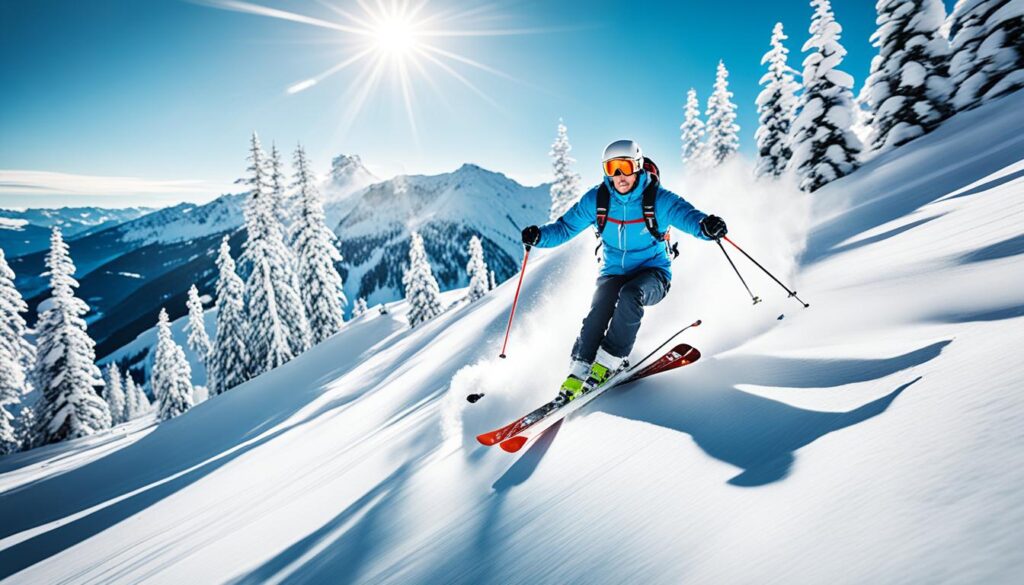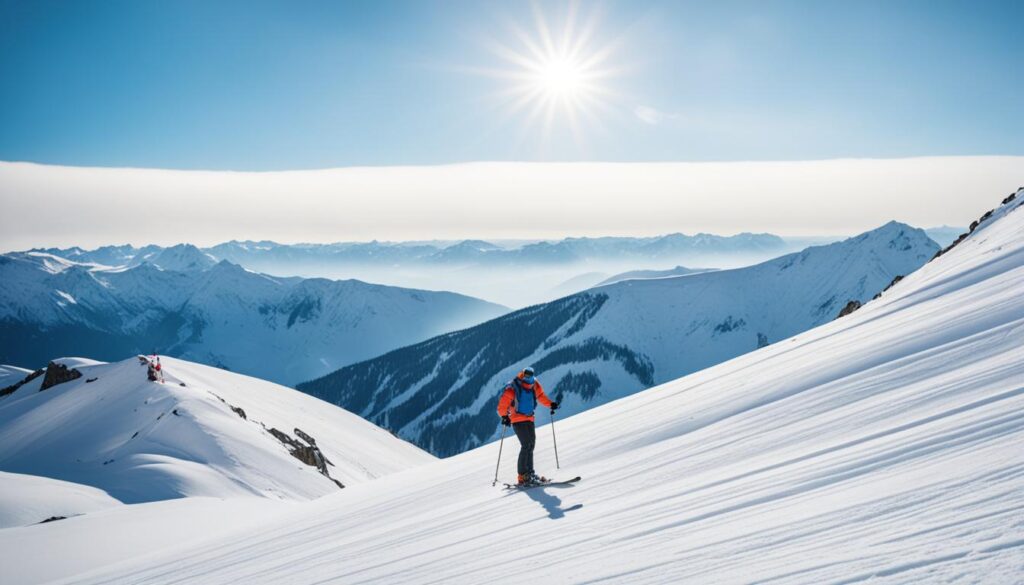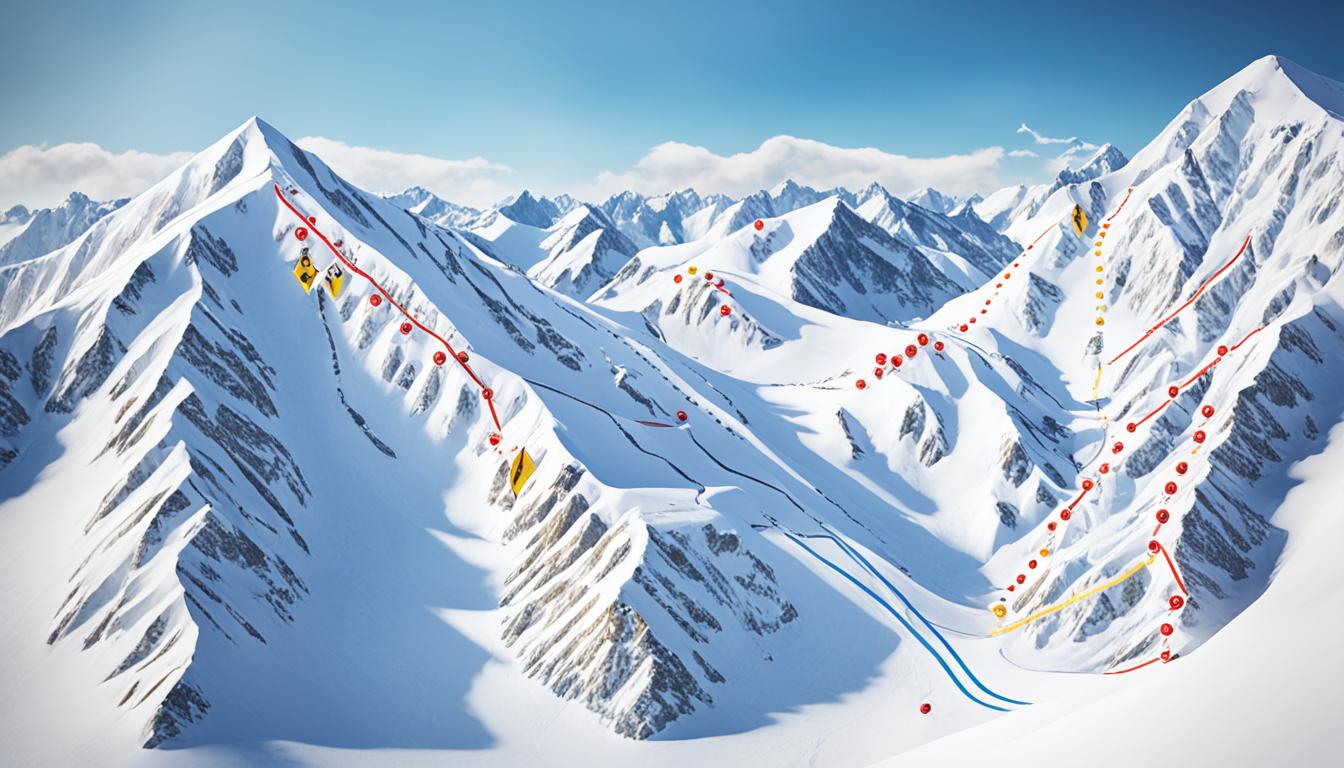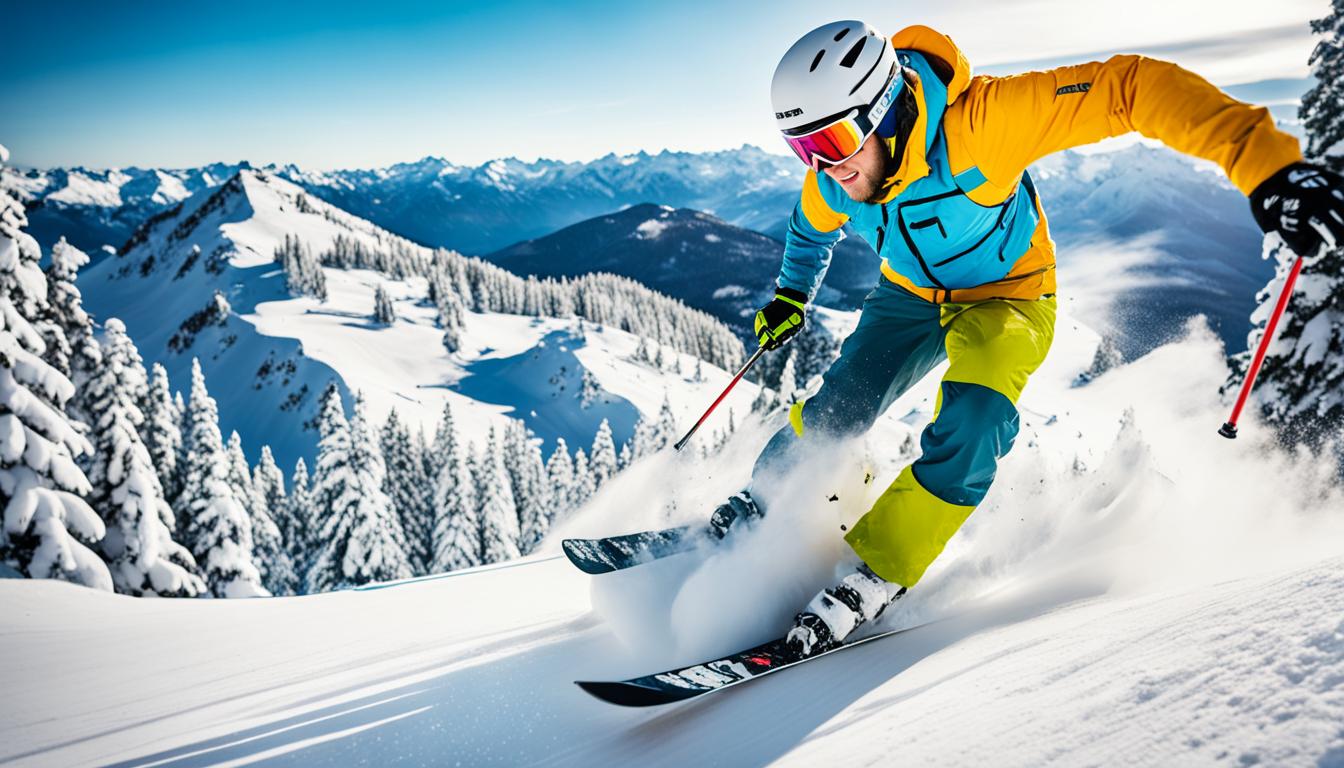As we witness the undeniable impact of climate change, it becomes evident that no industry is immune to its effects. In Colorado, a state renowned for its breathtaking mountain ranges and vibrant ski culture, the ski industry is facing significant challenges due to the changing climate.
The environmental impact of climate change is leading to noticeable shifts in snowfall patterns, which are crucial for the success of Colorado’s ski resorts and the enjoyment of winter sports enthusiasts. Rising temperatures and inconsistent snowfall pose a threat to the ski industry’s sustainability and the overall experience of visitors.
Key Takeaways:
- The ski industry in Colorado is experiencing the effects of climate change, with milder temperatures and reduced snowfall.
- Climate data indicates a warming trend in the U.S., affecting winter sports and ski resorts nationwide.
- Efforts to combat climate change and adopt sustainable practices are crucial for the long-term viability of the ski industry.
- Snowmaking operations play a crucial role in overcoming the challenges posed by climate change.
- The ski industry is actively working towards sustainability, reducing carbon emissions, and embracing renewable energy.
With these significant challenges at hand, it is important for stakeholders in the ski industry, as well as the larger community, to come together and find innovative solutions to mitigate the impact of climate change. By understanding the effects of climate change on Colorado ski seasons, we can collectively work towards preserving the beauty and thrill of winter sports for future generations.
The Role of Snowmaking in Overcoming Climate Challenges
Snowmaking operations have become a critical aspect of ski resorts’ strategies for overcoming the challenges posed by climate change. As global warming continues to affect winter weather patterns, ski seasons experience significant delays and ski area openings may be impacted. This has led to a heightened reliance on artificial snow production to ensure consistent snow coverage and extend the ski season.
With warming temperatures at higher elevations and reduced opportunities for natural snowfall, ski resorts are investing in snowmaking advancements to combat the effects of climate change. These advancements include state-of-the-art technologies and improved infrastructure to enhance snow production efficiency and provide high-quality skiing conditions.
By utilizing snowmaking operations, ski resorts can compensate for the lack of natural snow and open ski areas on schedule. This not only benefits the ski season by minimizing delays but also ensures that visitors have access to ample skiable terrain. The ability to produce artificial snow enables resorts to meet the demand for winter sports and maintain a stable ski industry despite the challenges posed by global warming.
Advancements in Snowmaking Technologies
The ski industry has witnessed remarkable progress in snowmaking technologies in recent years. These advancements include:
- Improved snowmaking equipment and machinery
- Enhanced snow gun designs and efficiency
- Smart snowmaking systems that optimize snow production based on weather conditions
- Integrated water management systems for efficient snowmaking operations
These innovations allow ski resorts to produce artificial snow more efficiently, conserve water resources, and create optimal snow quality for skiing and snowboarding.
The Benefits of Snowmaking Operations
“Snowmaking plays a crucial role in mitigating the impacts of climate change on ski resorts. It enables us to overcome the challenges of unpredictable snowfall and provide consistent skiing opportunities for our visitors.”
The benefits of snowmaking operations extend beyond ensuring a consistent ski season. These operations also support the local economy by attracting tourists and providing employment opportunities for communities reliant on winter tourism. Moreover, artificial snow production reduces the reliance on natural resources and promotes sustainability efforts within the ski industry.
As climate change continues to influence ski seasons, the importance of snowmaking operations in maintaining ski area openings and extending the ski season cannot be understated. Through ongoing advancements in snowmaking technologies and commitment to environmentally-conscious practices, ski resorts strive to overcome the climate challenges and ensure the enjoyment of winter sports for years to come.
Impacts of Climate Change on Ski Industry Sustainability
The ski industry in Colorado recognizes the pressing need to address the environmental impacts of climate change and is committed to pursuing sustainability efforts. Ski resorts are implementing various initiatives to reduce their carbon emissions, mitigate the environmental impact, and ensure the long-term viability of winter sports. By transitioning to renewable energy sources, improving energy efficiency, and adopting eco-friendly practices, ski resorts are taking significant steps towards creating a more sustainable future.
Transition to Renewable Energy
One of the key sustainability efforts in the ski industry is the transition to renewable energy sources. Ski resorts are investing in solar arrays, wind turbines, and other renewable energy technologies to power their operations. By generating clean energy on-site, resorts are reducing their reliance on fossil fuels and minimizing their carbon footprint. This shift towards renewable energy not only mitigates climate change but also sets an example for other industries to follow.
Improving Energy Efficiency
Another important aspect of ski industry sustainability is improving energy efficiency. Resorts are implementing energy-saving measures such as installing LED lighting, optimizing heating and cooling systems, and using advanced building insulation. By reducing energy consumption, ski resorts can minimize their environmental impact and decrease carbon emissions. These energy-efficient practices also lead to cost savings, making sustainability a win-win for both the environment and the bottom line.
Eco-Friendly Practices
Ski resorts are adopting a range of eco-friendly initiatives to minimize their environmental footprint. These practices include waste reduction and recycling programs, water conservation strategies, and the use of environmentally friendly products and materials. Resorts are also implementing green operations in areas such as food service, transportation, and landscaping. By embracing sustainable practices throughout their operations, ski resorts demonstrate their commitment to the environment and inspire visitors to adopt similar behaviors.
“Our sustainability efforts are driven by a deep concern for the environment and a commitment to preserve the natural beauty that is integral to our industry. By implementing renewable energy sources, improving energy efficiency, and adopting eco-friendly practices, we aim to mitigate the environmental impact of climate change and ensure a sustainable future for winter sports.”
– Ski Industry Representative
Lobbying and Collaboration
The ski industry is actively involved in lobbying efforts and collaborates with environmental organizations to advocate for climate change mitigation policies. By supporting legislation that aims to reduce greenhouse gas emissions and promote sustainability, ski resorts contribute to the broader global efforts in combatting climate change. This collective action demonstrates the industry’s commitment to being environmentally responsible and fostering a sustainable future.
Through a combination of renewable energy adoption, energy efficiency improvements, eco-friendly practices, and advocacy initiatives, the ski industry in Colorado is making significant strides towards sustainability. By addressing the environmental impacts of climate change, ski resorts are not only preserving the natural environment for future generations but also ensuring the long-term viability of the ski industry.

Future Projections for Colorado Ski Seasons
As we look ahead to the future of Colorado ski seasons, it is essential to consider the projected impacts of climate change. According to various models, average temperatures in Colorado are expected to rise by 2.5 to 5 degrees Fahrenheit by 2050. This significant warming trend poses a substantial risk to the ski industry and the overall ski season experience.
With these rising temperatures, we can anticipate several challenges that may affect ski seasons in Colorado. One of the key concerns is a reduction in snowfall, which translates to limited snow coverage on the slopes. Ski resorts may also experience shorter ski seasons due to the overall insufficient snowpack. At lower elevations, the risk of rain-on-snow events becomes more prominent, further impacting skiing conditions.
If current climate change scenarios persist, Colorado ski seasons could lose up to 60 days of snow coverage. This reduction in ski season length would undoubtedly have a significant economic impact, affecting not only the ski resorts but also the surrounding communities that rely on winter tourism.
Projected Impacts:
- Reduced snowfall
- Shorter ski seasons
- Increase in rain-on-snow events
- Economic losses for the industry
However, all hope is not lost. Efforts to combat climate change and adopt sustainable practices can potentially mitigate some of these impacts. By taking action to reduce greenhouse gas emissions and embracing sustainable technologies, we can work towards limiting the reduction in ski season length and safeguarding the future of Colorado’s ski industry.
To illustrate further, here’s a table illustrating the projected snowfall and ski season length:
| Year | Projected Snowfall (inches) | Ski Season Length (days) |
|---|---|---|
| 2025 | 300 | 120 |
| 2030 | 275 | 110 |
| 2035 | 250 | 100 |
| 2040 | 225 | 90 |
| 2045 | 200 | 80 |
This table provides a glimpse into the potential snowfall reduction and ski season length over the next few decades. It serves as a stark reminder of the need for proactive steps to address climate change and protect the ski industry’s economic viability and environmental sustainability.
The Socioeconomic Impact of Climate Change on Skiing Communities
The impact of climate change on ski seasons extends beyond the ski industry itself. Skiing communities heavily rely on winter tourism to support their local economies. The shorter ski seasons and reduced snowfall resulting from climate change have a ripple effect, affecting employment in tourism-related industries and the viability of seasonal businesses.
Skiing communities are now faced with the challenge of adapting to the changing climate and finding alternative sources of economic stability. Efforts are being made to diversify the local economy, attract year-round tourism, and invest in summer recreational activities to mitigate the socioeconomic impact of climate change on these communities.
Community Impact and Employment
The ski industry plays a crucial role in providing employment opportunities for local residents. Ski resorts, ski schools, restaurants, hotels, and other businesses directly linked to winter tourism create jobs and stimulate economic growth in these communities. However, with shorter ski seasons and the decline in visitors due to unpredictable snow conditions, employment opportunities are dwindling, and local residents are finding it increasingly challenging to sustain a stable income.
Seasonal businesses, which heavily rely on the ski season for their revenue, are particularly vulnerable to the impact of climate change. These businesses face the risk of closure or downsizing, leading to job losses and financial hardships for employees.
Climate Change Adaptation and Economic Stability
Skiing communities are proactively seeking strategies to adapt to the changing climate and ensure long-term economic stability. Diversifying the local economy by promoting year-round tourism is one such approach. By attracting visitors in the non-winter months through outdoor activities such as hiking, mountain biking, and festivals, communities can reduce their dependence on the ski season and generate revenue throughout the year.
Investing in summer recreational activities not only attracts visitors but also enhances the quality of life for local residents. This diversification allows communities to become resilient to the impacts of climate change while creating a more sustainable and stable economy.
In the face of climate change, skiing communities are embracing innovation and collaboration to adapt and thrive. By exploring new opportunities, implementing sustainable practices, and fostering community resilience, we can mitigate the socioeconomic impact of climate change and build a prosperous future for skiing communities.

| Impacts | Actions |
|---|---|
| Shorter ski seasons and reduced snowfall | Diversifying the local economy through year-round tourism |
| Decline in employment opportunities | Investing in summer recreational activities to create jobs |
| Viability of seasonal businesses at risk | Promoting sustainability and exploring innovative business models |
Addressing Climate Change Through Collective Action
Recognizing the urgency of the climate change issue, we, as ski industry stakeholders, are actively engaged in collective action. We collaborate with environmental advocacy groups, ski resorts, and industry associations to raise awareness, promote sustainable practices, and advocate for policies that address climate change on a global scale.
One of our key areas of focus is the transition to renewable energy sources. We recognize the importance of reducing greenhouse gas emissions and shifting away from fossil fuels. Many ski resorts are committed to sustainability goals, such as achieving zero net operating footprint and sourcing renewable energy. By investing in renewable energy infrastructure, such as solar arrays and wind farms, we can significantly reduce our carbon footprint and contribute to global emissions reduction.
Collaboration among ski industry competitors is also observed, as we come together to combat climate change and present a united front. By sharing best practices, technologies, and knowledge, we can accelerate progress in addressing climate change and its impacts on ski seasons.
Examples of Ski Industry Collaboration Efforts
In our collective endeavors, we have witnessed remarkable collaboration within the ski industry. Here are a few examples of notable initiatives:
- Climate change activism: Ski resorts and industry associations actively participate in climate change protests, rallies, and awareness campaigns. By lending our voices to this global movement, we aim to draw attention to the urgent need for action and encourage others to join us in protecting the environment.
- Lobbying efforts: We engage in lobbying activities to advocate for policies that support renewable energy transition and foster global emissions reduction. By working with legislators and policymakers, we can influence decision-making processes and promote sustainable practices on a larger scale.
- Collaborative research and development: Ski resorts collaborate with research institutions and environmental organizations to develop innovative solutions to combat climate change. This includes advancements in snowmaking technology, energy-efficient infrastructure, and sustainable water management practices.
Quote
“By coming together as an industry, we have the power to make a real difference in addressing climate change. Our collective efforts are essential in preserving the future of skiing and protecting the environment for generations to come.”
| Benefits of Ski Industry Collaboration | Examples |
|---|---|
| Enhanced knowledge sharing | Joint sustainability conferences and workshops |
| Elevated industry influence | Collaborative lobbying for renewable energy policies |
| Accelerated sustainability initiatives | Shared research and development projects |
| Increased public awareness | Joint marketing campaigns promoting sustainable practices |
| Collective resource optimization | Pooling funds for renewable energy installations |
Conclusion
The impact of climate change on Colorado ski seasons is undeniable and poses significant challenges to the ski industry. However, we, as ski resorts, industry stakeholders, and communities, are committed to long-term sustainability and adapting to the changing climate. Through advancements in snowmaking technology, sustainability initiatives, collective action, and advocacy efforts, we have hope for mitigating the impacts of climate change on ski seasons.
As an industry, we recognize the critical need to be environmentally conscious and act as stewards of the natural environment in order to ensure the future of winter sports and preserve the beloved skiing culture in Colorado. We understand that our actions have implications beyond our industry and impact the broader environment and local communities. That’s why we are dedicated to implementing innovative solutions to reduce our carbon footprint and minimize environmental harm.
By investing in advanced snowmaking technologies, we are ensuring consistent snow coverage and extending the ski season despite the challenges posed by global warming. Additionally, we are actively pursuing sustainability initiatives such as transitioning to renewable energy sources, improving energy efficiency, and adopting eco-friendly practices. These efforts not only contribute to long-term sustainability but also serve as a testament to our commitment to environmental stewardship.
Collective action is key in addressing climate change, and we are proud to collaborate with environmental advocacy groups, industry associations, and even our competitors to raise awareness, promote sustainable practices, and advocate for policies that address climate change on a global scale. Together, we can make a difference.
FAQ
What is the impact of climate change on Colorado ski seasons?
Climate change is causing milder temperatures and reduced snowfall, resulting in delayed resort openings and limited skiable terrain.
How are ski resorts overcoming the challenges of climate change?
Ski resorts are investing in advanced snowmaking technologies and infrastructure to ensure consistent snow coverage and extend the ski season.
What sustainability efforts are the ski industry in Colorado implementing?
Ski resorts are transitioning to renewable energy sources, improving energy efficiency, and adopting eco-friendly practices to reduce their carbon footprint.
What are the future projections for Colorado ski seasons?
Models predict a rise in average temperatures, which could result in reduced snowfall, shorter ski seasons, and more rain-on-snow events.
How does climate change impact skiing communities and the local economy?
Shorter ski seasons and reduced snowfall can affect employment in tourism-related industries and the viability of seasonal businesses.
How is the ski industry addressing climate change through collective action?
Ski industry stakeholders are collaborating to raise awareness, promote sustainable practices, and advocate for policies that address climate change on a global scale.
What are the key takeaways regarding the impact of climate change on Colorado ski seasons?
Climate change poses significant challenges to the ski industry, but efforts towards sustainability and adaptation offer hope for mitigating its impacts and preserving the future of skiing.




